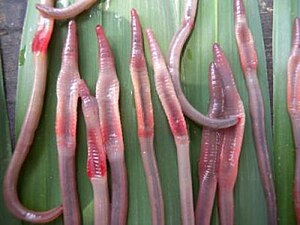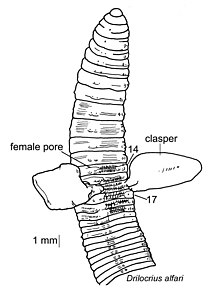Almidae
| Almidae | ||||||||||||
|---|---|---|---|---|---|---|---|---|---|---|---|---|

Semi Aquatic Crassiclitellaten the genus Glyphidrilus |
||||||||||||
| Systematics | ||||||||||||
|
||||||||||||
| Scientific name | ||||||||||||
| Almidae | ||||||||||||
| Duboscq , 1902 |
Almidae is the name of a family of little bristles in the order of the Crassiclitellata (earthworms in the broader sense) that are common in Central America , South America , Africa and Asia and live in freshwater in the soil .
features
The body of the Almidae has a rectangular cross-section, at least behind the clitellum , at the edges of which are four pairs of bristles per segment , and has no dorsal pores, but there is a dorsal groove.
At 1 to 3 extensions of the esophagus are located between the 5th and the 9th segment 1 to 3 gizzards , while there is no gizzard in the midgut. Calcium glands are also missing. The closed blood vessel system of the Almidae has a similarly constructed supra-esophageal vessel in the front part of the body next to the back vessel. The large nephridia are well developed.
The clitellum the hermaphrodite is annular, but may vary in size and location. In the genus Callidrilus it occupies 19 to 29 segments, beginning with or behind the 12th segment, in the genera Drilocrius and Glyphidrilocrius about 22 to 30 segments, starting directly behind the male sexual opening , in the genus Glyphidrilus 17 to 35 segment from the 42nd segment; in the genus Alma 20 to 69 segments between the 35th and 295th segment. The pubertal tuberosity is rib-shaped ( Callidrilus ), wing-shaped ( Glyphidrilus and Glyphidrilocrius ) or nonexistent ( Alma and Drilocrius ).

The only pair of inconspicuous male genital orifices lies between the 15th and 30th segment either in front of or within the clitellum, sometimes - as in Drilocrius - at the base of paired genital lobes or - as in Alma - at the distal end of ribbon-shaped valves. Only representatives of the genus Callidrilus have prostates. The adiverticulate (no blind sacs), partially or completely interparietal receptacula seminis open outwards via numerous inconspicuous openings in the furrows between the 7th and 200th segments, mostly behind the testicular segments along the rows of bristles.
Distribution, habitat and way of life
The Almidae are distributed in the tropical regions of Central America , South America and Africa as well as in Asia in India , Myanmar , Malaysia and Indonesia . They live as substrate eater in fresh water at the bottom of inland waters , often in the mud on the edge of rivers .
Development cycle
Like all belt worms , the Almidae are hermaphrodites that mate with each other when they mate. With the help of mucus deposits from the clitellum, egg cocoons are formed in which the embryos develop into small young worms.
Genera
The Almidae family has about 6 genera :
literature
- Octave Joseph Duboscq (1902): Alma zebanguii n.sp. et les Alminae oligochetes de la famille des Glossoscolecidae Mich. Archives de zoologie expérimentale et générale, notes 3, 10 (7), xcvii – cvi.
- Reginald William Sims (1981): A classification and the distribution of earthworms, suborder Lumbricina (Haplotaxida: Oligochaeta). Bulletin of the British Museum (Natural History), Zoology Series 39 (2), pp. 103–124, here p. 111.
- Ratmanee Chanabun, Chirasak Sutcharit, Piyoros Tongkerd, Somsak Panha (2013): The semi-aquatic freshwater earthworms of the genus Glyphidrilus Horst, 1889 from Thailand (Oligochaeta, Almidae) with re-descriptions of several species. ZooKeys 265, pp. 1-76.
- Barrie GM Jamieson, Marco Ferraguti: Non-leech Clitellata. In: Greg Rouse, Fredrik Pleijel (Eds.): Reproductive Biology and Phylogeny of Annelida. Science Publishers, Enfield (NH) 2006. Chapter 8, pp. 235-392. Drilocrius alfari (illustration) p. 320, Almidae 319–321.
